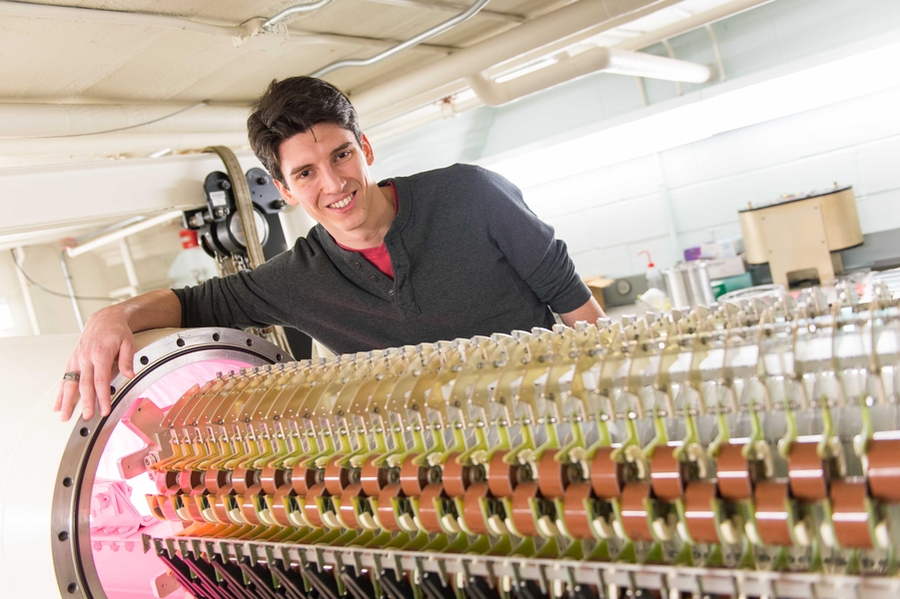Like many in the MIT community, Jake Jurewicz has felt a lifelong attraction to engineering. “Growing up, all I ever played with were Legos and Lincoln Logs, things that involved building,” he recalls.
That love of making things found a challenging and rewarding engagement in the summer of 2012, when Jurewicz, an NSE-Physics double major fresh off his sophomore year, received a National Undergraduate Fellowship (NUF) to develop new simulation and visualization software at the National Fusion Facility (NFF) in La Jolla, Calif. He credits NSE Assistant Professor Anne White with encouraging him to apply for the fellowship, which took him to one of just three tokamak fusion reactors in the United States, a list that includes MIT’s Alcator C-Mod.
After a weeklong orientation with about 40 other NUF fellows at Princeton University’s Plasma Physics Lab (home of the third U.S. tokamak), Jurewicz joined a General Atomics team that is working to improve the performance of the NFF’s DIII-D tokamak as part of the broad international effort to realize the game-changing potential of fusion as a practical energy source. One basic challenge is generating extremely high temperatures, comparable to those in the core of a star. While Alcator does this with RF energy, DIII-D utilizes beams of deuterium, a hydrogen isotope.
“DIII-D has eight school-bus sized neutral beam injectors, that inject neutral deuterium particles into the tokamak,” Jurewicz explains. “When the particles hit the plasma, they ionize and start being moved by the tokamak’s magnetic fields. As they collide with other particles they disperse their energy into the plasma, and ultimately heat it.”
However, up to 30 percent of the beam energy is wasted when newly ionized deuterium particles hit the reactor wall during their first orbit. This “prompt loss” creates inefficiency that undermines the reactor’s ability to put out more energy than it consumes, and can also create heat flux that damages reactor walls and instrumentation.
The General Atomics team, which included NSE alum Ray Fisher and former post-doc David Pace, had collected substantial data on prompt loss, including information about a heat flux that threatened an important polarimeter in the chamber wall. “I built a simulator, PLOWS, that lets you plug in the plasma and neutral beam parameters and see very quickly if the losses were localized or spread out,” Jurewicz says. “That helps determine whether changing parameters could move flux away from a given point, so that you can protect the equipment.”
Read more
That love of making things found a challenging and rewarding engagement in the summer of 2012, when Jurewicz, an NSE-Physics double major fresh off his sophomore year, received a National Undergraduate Fellowship (NUF) to develop new simulation and visualization software at the National Fusion Facility (NFF) in La Jolla, Calif. He credits NSE Assistant Professor Anne White with encouraging him to apply for the fellowship, which took him to one of just three tokamak fusion reactors in the United States, a list that includes MIT’s Alcator C-Mod.
After a weeklong orientation with about 40 other NUF fellows at Princeton University’s Plasma Physics Lab (home of the third U.S. tokamak), Jurewicz joined a General Atomics team that is working to improve the performance of the NFF’s DIII-D tokamak as part of the broad international effort to realize the game-changing potential of fusion as a practical energy source. One basic challenge is generating extremely high temperatures, comparable to those in the core of a star. While Alcator does this with RF energy, DIII-D utilizes beams of deuterium, a hydrogen isotope.
“DIII-D has eight school-bus sized neutral beam injectors, that inject neutral deuterium particles into the tokamak,” Jurewicz explains. “When the particles hit the plasma, they ionize and start being moved by the tokamak’s magnetic fields. As they collide with other particles they disperse their energy into the plasma, and ultimately heat it.”
However, up to 30 percent of the beam energy is wasted when newly ionized deuterium particles hit the reactor wall during their first orbit. This “prompt loss” creates inefficiency that undermines the reactor’s ability to put out more energy than it consumes, and can also create heat flux that damages reactor walls and instrumentation.
The General Atomics team, which included NSE alum Ray Fisher and former post-doc David Pace, had collected substantial data on prompt loss, including information about a heat flux that threatened an important polarimeter in the chamber wall. “I built a simulator, PLOWS, that lets you plug in the plasma and neutral beam parameters and see very quickly if the losses were localized or spread out,” Jurewicz says. “That helps determine whether changing parameters could move flux away from a given point, so that you can protect the equipment.”
Read more






